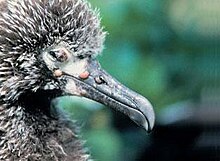| Fowlpox virus | |
|---|---|

| |
| Example of clinical signs produced by Fowlpox virus | |
| Virus classification | |
| (unranked): | Virus |
| Realm: | Varidnaviria |
| Kingdom: | Bamfordvirae |
| Phylum: | Nucleocytoviricota |
| Class: | Pokkesviricetes |
| Order: | Chitovirales |
| Family: | Poxviridae |
| Genus: | Avipoxvirus |
| Species: | Fowlpox virus
|
Fowlpox is the worldwide disease of poultry caused by viruses of the family Poxviridae and the genus Avipoxvirus. The viruses causing fowlpox are distinct from one another but antigenically similar, possible hosts including chickens, turkeys, quail, canaries, pigeons, and many other species of birds. There are two forms of the disease. The first (dry form) is spread by biting insects (especially mosquitoes) and wound contamination, and causes lesions on the comb, wattles, and beak. Birds affected by this form usually recover within a few weeks. The second (wet form) is contracted by inhalation or ingestion of the virus via dust (i.e. dander, representing virus-infected cells shed from cutaneous lesions) or aerosols, leading to the 'diphtheritic form' of the disease, in which diphtheritic membranes form in the mouth, pharynx, larynx, and sometimes the trachea. The prognosis for this form is poor.[1]
- ^ Skinner, M.A. (2008). "Fowlpox Virus and Other Avipoxviruses". Encyclopedia of Virology. pp. 274–284. doi:10.1016/B978-012374410-4.00403-9. ISBN 978-0-12-374410-4.